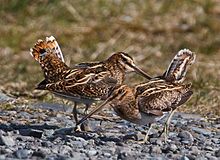- Common Snipe
-
Common Snipe 
Conservation status Scientific classification Kingdom: Animalia Phylum: Chordata Class: Aves Order: Charadriiformes Family: Scolopacidae Genus: Gallinago Species: G. gallinago Binomial name Gallinago gallinago
(Linnaeus, 1758)Subspecies G. g. faroeensis
G. g. gallinagoSynonyms Capella gallinago
The Common Snipe (Gallinago gallinago) is a small, stocky wader native to the Old World. The breeding habitat is marshes, bogs, tundra and wet meadows throughout northern Europe and northern Asia. It is migratory, with European birds wintering in southern and western Europe and Africa (south to the Equator), and Asian migrants moving to tropical southern Asia.
Contents
Description
 G. g. faeroeensis in Iceland
G. g. faeroeensis in Iceland
Adults are 25–27 cm in length with a 44–47 cm wingspan and a weight of 80–140 g (up to 180 g pre-migration). They have short greenish-grey legs and a very long (5.5–7 cm) straight dark bill. The body is mottled brown with straw-yellow stripes on top and pale underneath. They have a dark stripe through the eye, with light stripes above and below it. The wings are pointed.[2][3]
It is the most widespread of several similar snipes. It most closely resembles the Wilson's Snipe G. delicata of North America, which was until recently considered to be a subspecies G. g. delicata of Common Snipe. They differ in the number of tail feathers, with seven pairs in G. gallinago and eight pairs in G. delicata; the North American species also has a slightly wider white edge to the wings.[4][5] Both species breed in the Aleutian Islands.[2] It is also very similar to the Pin-tailed Snipe G. stenura and Swinhoe's Snipe G. megala of eastern Asia; identification of these species there is complex.[6]
There are two subspecies of Common Snipe, G. g. faeroeensis in Iceland, the Faroes, Shetland and Orkney (wintering in Britain and Ireland), and G. g. gallinago in the rest of the Old World.
Ecology
It is a well camouflaged bird is usually shy and conceals itself close to ground vegetation and flushes only when approached closely. When flushed, they utter a sharp note that sounds like scape, scape and fly off in a series of aerial zig-zags to confuse predators.[7] They forage in soft mud, probing or picking up food by sight. They mainly eat insects and earthworms, also some plant material.[3]
The male performs "winnowing" display during courtship, flying high in circles and then taking shallow dives to produce a "drumming" sound by vibrating its tail feathers. This sound has been compared by others to the bleating of a sheep or goat; hence in many languages the Snipe is known by names signifying “Flying Goat,” “Heaven's Ram,” as in Scotland by “Heather-bleater”[7] and in Finnish the name taivaanvuohi, "sky goat". Common Snipe nest in a well-hidden location on the ground, laying four eggs of a dark olive colour, blotched and spotted with rich brown,[7] which are incubated by the female for 18–21 days. The young when freshly hatched are covered in down of a dark maroon, variegated with black, white and buff.[7] The young are cared for by both parents, each parent looking after half the brood, with fledging in 10–20 days.[2][3]
Conservation
Overall, the species is not threatened. Populations on the southern fringes of the breeding range in Europe are however declining with local extinction in some areas (notably in parts of England and Germany), mainly due to field drainage and agricultural intensification.[2] The Agreement on the Conservation of African-Eurasian Migratory Waterbirds (AEWA) applies to the species. It is still hunted as a gamebird in much of its range.[2]
History
Old folk names include "mire snipe", "horse gowk", "heather bleat", and the variant spelling "snite".[8] See also snipe for other aspects of the name.
References
- ^ BirdLife International (2005). Gallinago gallinago. 2006. IUCN Red List of Threatened Species. IUCN 2006. www.iucnredlist.org. Retrieved on 12 May 2006. Database entry includes justification for why this species is of least concern
- ^ a b c d e Hoyo, J. del, et al., eds. (1996). Handbook of the Birds of the World, vol. 3. Barcelona: Lynx Edicions. pp. 496. ISBN 84-87334-20-2.
- ^ a b c Snow, D. W., & Perrins, C. M. (1998). The Birds of the Western Palearctic, Concise Edition (Vol. 1), Oxford University Press, Oxford.
- ^ Leader, P. (1999). Identification forum: Common Snipe and Wilson's Snipe Birding World 12(9): 371-4
- ^ Reid, M. (2008). Identification of Wilson's and Common Snipe British Birds 101 (4): 189-200.
- ^ Carey, G. & Olsson, U. (1995). Field Identification of Common, Wilson's, Pintail and Swinhoe's Snipes. Birding World 8 (5): 179-190.
- ^ a b c d
 One or more of the preceding sentences incorporates text from a publication now in the public domain: Chisholm, Hugh, ed (1911). "Snipe". Encyclopædia Britannica (11th ed.). Cambridge University Press.
One or more of the preceding sentences incorporates text from a publication now in the public domain: Chisholm, Hugh, ed (1911). "Snipe". Encyclopædia Britannica (11th ed.). Cambridge University Press. - ^ Lockwood, W. B. (1984). The Oxford Book of British Bird Names. Oxford University Press ISBN 0-19-214155-4.
External links
- Common Snipe videos, photos & sounds on the Internet Bird Collection
- Ageing and sexing (PDF) by Javier Blasco-Zumeta
- Avibase
Game animals and shooting in the United Kingdom Game birds Common Pheasant · Grey Partridge · Red-legged Partridge · Red Grouse · Rock Ptarmigan · Black Grouse1 · Eurasian Woodcock · Common SnipeQuarry species Mallard · Teal · Wood Pigeon · Golden Plover · Canada Goose · Greylag Goose · Pink-footed Goose · Greater White-fronted Goose2 · Eurasian Wigeon · Tufted Duck · Northern Shoveler · Northern Pintail · Gadwall · Common Pochard · Common Goldeneye · Common Moorhen · Eurasian CootDeer Other quarry Opponents Law See also 1 Rarely shot due to declining numbers.
2 England and Wales only; protected Scotland.Categories:- IUCN Red List least concern species
- Gallinago
- Shorebirds
- Birds of Asia
- Birds of Europe
- Birds of Iceland
- Game birds
Wikimedia Foundation. 2010.


